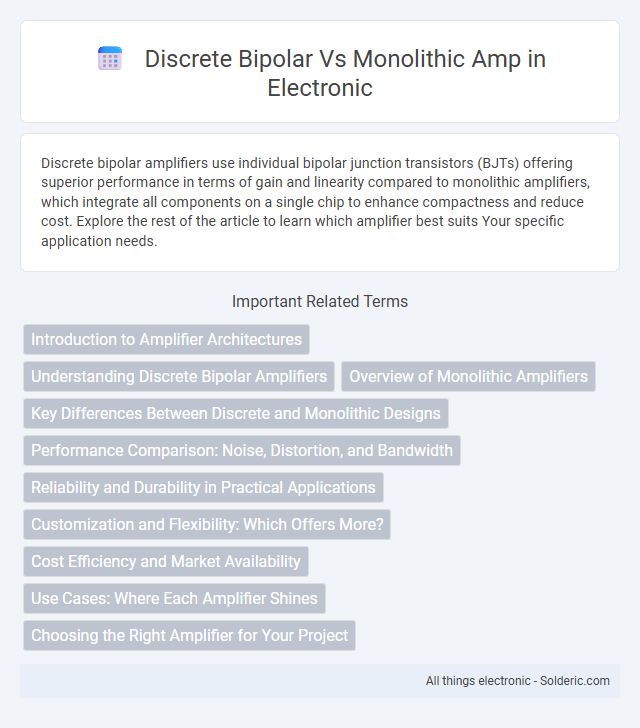Discrete bipolar amplifiers use individual bipolar junction transistors (BJTs) offering superior performance in terms of gain and linearity compared to monolithic amplifiers, which integrate all components on a single chip to enhance compactness and reduce cost. Explore the rest of the article to learn which amplifier best suits Your specific application needs.
Comparison Table
| Feature | Discrete Bipolar Amplifier | Monolithic Amplifier |
|---|---|---|
| Component Type | Individual transistors and components assembled separately | Integrated circuit with all components on a single chip |
| Size | Larger, due to separate components | Compact, minimal footprint |
| Performance | High power handling, customizable | Consistent performance, optimized design |
| Reliability | Lower, due to more interconnections | Higher, fewer connections and defects |
| Frequency Response | Wide bandwidth possible, limited by layout | High frequency optimized, limited by process |
| Cost | Higher manufacturing cost, labor intensive | Lower cost, mass production |
| Thermal Management | Easier to manage heat with separate components | Thermal limited due to chip size |
| Application | High power, discrete tuning, audio amps | General-purpose, low power, consumer electronics |
Introduction to Amplifier Architectures
Discrete bipolar amplifiers use individual bipolar junction transistors (BJTs) configured for high gain and low noise, making them ideal for precision applications. Monolithic amplifiers integrate multiple transistor components onto a single silicon chip, offering compactness and improved thermal stability. Understanding the differences in architecture helps you choose the right amplifier for your specific performance and design requirements.
Understanding Discrete Bipolar Amplifiers
Discrete bipolar amplifiers use individual bipolar junction transistors (BJTs) to achieve high gain and low noise performance, making them ideal for precision analog circuits. Their modular design allows for better thermal management and easier customization compared to monolithic amplifiers, which integrate all components on a single chip. Understanding discrete bipolar amplifiers helps you optimize your circuit's performance by leveraging their superior linearity and low distortion characteristics.
Overview of Monolithic Amplifiers
Monolithic amplifiers integrate multiple transistor stages and passive components onto a single silicon chip, offering compact size and consistent performance with improved reliability compared to discrete bipolar amplifiers. Their fabrication process allows for precise matching of components, resulting in low noise, high gain, and wide bandwidth ideal for high-frequency applications. You benefit from reduced parasitic elements and thermal stability, making monolithic amplifiers suitable for modern communication and signal processing systems.
Key Differences Between Discrete and Monolithic Designs
Discrete bipolar amplifiers use individual transistor components for each stage, offering superior thermal stability and easier customization compared to monolithic amplifiers, which integrate all components onto a single silicon chip for compactness and cost-efficiency. Monolithic designs typically provide higher reliability and consistency due to integrated manufacturing, while discrete designs excel in high-frequency performance and power handling due to their flexibility in component selection. Your choice depends on whether you prioritize precision and customization or integration and size in your application.
Performance Comparison: Noise, Distortion, and Bandwidth
Discrete bipolar amplifiers typically exhibit lower noise and distortion levels due to their individually selected components, enabling superior signal integrity for precision applications. Monolithic amplifiers, integrated on a single chip, offer consistent bandwidth performance but may have higher noise floors and distortion compared to discrete designs because of component limitations and thermal coupling. Your choice depends on whether minimizing noise and distortion or maximizing convenience and bandwidth uniformity is more critical for your specific audio or measurement system.
Reliability and Durability in Practical Applications
Discrete bipolar amplifiers offer superior reliability and durability in practical applications due to their individual component design, which allows for easier maintenance and replacement of faulty parts, minimizing downtime. Monolithic amplifiers, while compact and cost-effective, tend to have lower durability because a failure in the integrated circuit often requires complete replacement rather than repair. The modular nature of discrete bipolar amps typically results in better thermal management and longer operational life under high-stress conditions.
Customization and Flexibility: Which Offers More?
Discrete bipolar amplifiers provide greater customization and flexibility due to their individual transistor components, allowing you to tailor performance characteristics such as gain, bandwidth, and linearity. Monolithic amplifiers, built on integrated circuits, offer limited adjustability but excel in consistency and compactness. For applications demanding precise tuning and specialized configurations, discrete bipolar amps are the more adaptable choice.
Cost Efficiency and Market Availability
Discrete bipolar amplifiers generally have lower initial costs due to simpler component sourcing, but their assembly and maintenance can increase long-term expenses. Monolithic amplifiers offer higher market availability with integrated designs, reducing manufacturing complexity and enhancing cost efficiency for mass production. Your choice depends on balancing upfront budget constraints with the scalability and reliability offered by monolithic solutions.
Use Cases: Where Each Amplifier Shines
Discrete bipolar amplifiers excel in high-frequency and precision applications such as RF circuits, instrumentation, and audio amplifiers requiring low noise and high gain. Monolithic amplifiers are preferred in integrated circuits, consumer electronics, and cost-sensitive mass production due to their compact size, reliability, and ease of integration. Both amplifier types offer distinct advantages, with discrete designs optimized for performance-critical tasks and monolithic amps favored for scalability and integration.
Choosing the Right Amplifier for Your Project
Choosing the right amplifier for your project depends on the specific performance requirements and design constraints. Discrete bipolar amplifiers offer superior thermal stability, higher gain, and better noise performance due to individually selected components, making them ideal for high-precision audio or RF applications. Monolithic amplifiers provide compact size, cost efficiency, and ease of integration, making them suitable for mass-produced, general-purpose circuits where space and simplicity are priorities.
Discrete bipolar vs Monolithic amp Infographic

 solderic.com
solderic.com